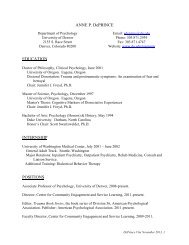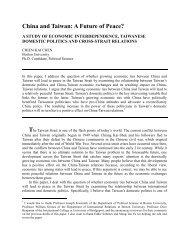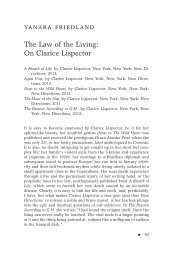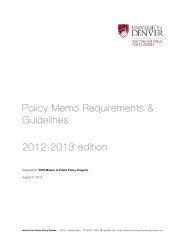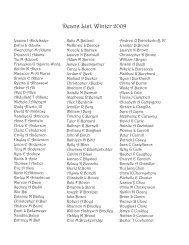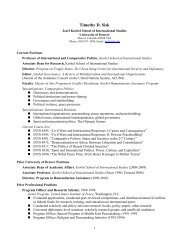Through a Speculum That Shines: Vision and Imagination in ...
Through a Speculum That Shines: Vision and Imagination in ...
Through a Speculum That Shines: Vision and Imagination in ...
You also want an ePaper? Increase the reach of your titles
YUMPU automatically turns print PDFs into web optimized ePapers that Google loves.
History of Religions Feb 1997 v36 n3 p265(10) Page 1<br />
<strong>Through</strong> a <strong>Speculum</strong> <strong>That</strong> <strong>Sh<strong>in</strong>es</strong>: <strong>Vision</strong> <strong>and</strong> <strong>Imag<strong>in</strong>ation</strong> <strong>in</strong> Medieval<br />
Jewish Mysticism.<br />
by Arthur Green<br />
© COPYRIGHT 1997 University of Chicago Press<br />
By Elliot Wolfson. Pr<strong>in</strong>ceton, N.J.: Pr<strong>in</strong>ceton University<br />
Press, 1994. Pp. x+452. $49.50 (cloth).<br />
Scholars of Jewish mysticism, ever conscious that they<br />
labor still <strong>in</strong> the shadow of the great Gershom Scholem<br />
(1897-1982), virtual founder of the discipl<strong>in</strong>e, are used to<br />
th<strong>in</strong>k<strong>in</strong>g of their field as centered <strong>in</strong> Jerusalem among<br />
Scholem’s students, successors, <strong>and</strong> critics. More than <strong>in</strong><br />
any area of Judaic studies, research <strong>in</strong> Jewish mysticism<br />
<strong>in</strong> North America has played a rather secondary role. Elliot<br />
Wolfson’s magnificent <strong>Through</strong> a <strong>Speculum</strong> <strong>That</strong> <strong>Sh<strong>in</strong>es</strong>:<br />
<strong>Vision</strong> <strong>and</strong> <strong>Imag<strong>in</strong>ation</strong> <strong>in</strong> Medieval Jewish Mysticism,<br />
followed <strong>in</strong> short order by two volumes of collected shorter<br />
studies, goes a long way toward chang<strong>in</strong>g that situation.(1)<br />
Wolfson is clearly <strong>in</strong> the first rank of Kabbalah scholars,<br />
the first American s<strong>in</strong>ce the late Alex<strong>and</strong>er Altmann to<br />
achieve that status. His <strong>Through</strong> a <strong>Speculum</strong> <strong>That</strong> <strong>Sh<strong>in</strong>es</strong><br />
has received both the National Jewish Book Award <strong>and</strong><br />
the Award of Excellence of the American Academy of<br />
Religion--honors richly deserved by this major work of<br />
scholarship.<br />
<strong>Through</strong> a <strong>Speculum</strong> <strong>That</strong> <strong>Sh<strong>in</strong>es</strong> is essentially a study of<br />
the place <strong>and</strong> various underst<strong>and</strong><strong>in</strong>gs of visual religious<br />
experience <strong>in</strong> Judaism from the beg<strong>in</strong>n<strong>in</strong>g of the Common<br />
Era through the High Middle Ages. Its scope <strong>in</strong>cludes both<br />
accounts of vision by Jews <strong>in</strong> the rabb<strong>in</strong>ic <strong>and</strong> medieval<br />
periods <strong>and</strong> explanations by th<strong>in</strong>kers <strong>in</strong> those eras of<br />
visions recounted <strong>in</strong> the biblical text itself. While highly<br />
sophisticated <strong>in</strong> his use of typologies <strong>and</strong> various other<br />
phenomenological tools, Wolfson, like Moshe Idel <strong>and</strong><br />
most scholars <strong>in</strong> this field (follow<strong>in</strong>g a model set by<br />
Scholem himself), comb<strong>in</strong>es the historical <strong>and</strong><br />
phenomenological approaches, giv<strong>in</strong>g us a treatment that<br />
progresses chronologically through the sources, but<br />
always with an eye to typologies of mystical experience, to<br />
the relationship of m<strong>in</strong>d <strong>and</strong> eye <strong>in</strong> the envisag<strong>in</strong>g of that<br />
which is beyond sight, <strong>and</strong> to the complex <strong>in</strong>terplay of<br />
experience <strong>and</strong> hermeneutics. There is also a special<br />
concern with gender questions <strong>and</strong> with psychosexual<br />
read<strong>in</strong>gs of the sources, nourished primarily by the very<br />
strong <strong>in</strong>fluence of French critic Luce Irigaray.<br />
First, it must be said that this is a tremendously ambitious<br />
undertak<strong>in</strong>g, <strong>and</strong> one that is accomplished with remarkable<br />
success, <strong>in</strong>clud<strong>in</strong>g lucidity <strong>and</strong> grace of style. Wolfson<br />
transcends the barriers between rabb<strong>in</strong>ics, merkovah,<br />
poetry, philosophy, <strong>and</strong> Kabbalah to give us a richly<br />
panoramic view of visionary experience throughout<br />
classical Judaism. He draws on a number of his own prior<br />
studies to show these l<strong>in</strong>ks, cutt<strong>in</strong>g his way deftly through<br />
a thicket of extraord<strong>in</strong>arily difficult <strong>and</strong> often obscure<br />
geonic <strong>and</strong> early medieval sources, many of which are<br />
preserved only <strong>in</strong> manuscript. For its erudition <strong>and</strong> the<br />
treasures of its footnotes alone, this is a major work <strong>and</strong><br />
one that will long be seen as a basis for further<br />
scholarship.<br />
<strong>Vision</strong>ary experience is a problem already <strong>in</strong> the Hebrew<br />
Scriptures that form the basis of all later versions of<br />
Judaism. There is a strong tendency <strong>in</strong> Scripture toward a<br />
fully aniconic underst<strong>and</strong><strong>in</strong>g of God (Deuteronomy 4-6 is<br />
the locus classicus of this view) while other passages<br />
(Exodus 24, Isaiah 6, Ezekiel 1) speak <strong>in</strong> boldly visual <strong>and</strong><br />
anthropomorphic terms.(2) The unresolved tension<br />
between these views br<strong>in</strong>gs about an extraord<strong>in</strong>arily rich<br />
discussion <strong>in</strong> the later sources, revolv<strong>in</strong>g around the<br />
question of whether visions are actual depictions of God<br />
as He manifests Himself, creations of the human<br />
imag<strong>in</strong>ation, or (the usual medieval solution) some subtle<br />
comb<strong>in</strong>ation of the two. Wolfson has mastered <strong>and</strong><br />
clarified all of this complicated material, show<strong>in</strong>g the<br />
reader how for Jewish tradition "the imag<strong>in</strong>ation is the<br />
faculty that allows the formless essence of the hidden God<br />
to be manifest as a visible presence <strong>in</strong> the heart of the<br />
pious soul" (p. 324).<br />
Part of this focus on the imag<strong>in</strong>ation is created by an<br />
<strong>in</strong>terest<strong>in</strong>g (<strong>and</strong> perhaps not <strong>in</strong>cidental) feature of the<br />
Hebrew language. The word stem DMH, mean<strong>in</strong>g "to be<br />
like," is used <strong>in</strong> its second conjugation as "to imag<strong>in</strong>e."<br />
Thus the noun dimayon can mean both "similarity" <strong>and</strong><br />
"imag<strong>in</strong>ation." The prophet "likens" God to man, "images"<br />
God (i.e., attributes form to the formless God), <strong>and</strong><br />
"imag<strong>in</strong>es" Him all by the same word. This co<strong>in</strong>cidence of<br />
mean<strong>in</strong>gs makes both for <strong>in</strong>terest<strong>in</strong>g wordplays <strong>and</strong><br />
genu<strong>in</strong>e confusion <strong>in</strong> the <strong>in</strong>terpretation of such key<br />
passages as Gen. 1:26 ("Let us make a human <strong>in</strong> our<br />
image, after our likeness"), Isa. 40:18 ("To whom will you<br />
liken God, <strong>and</strong> what image will you attribute to Him?"), <strong>and</strong><br />
Hos. 12:11 ("By the h<strong>and</strong> of the prophet I am imaged").<br />
The words demut, tedammeyun, <strong>and</strong> adammeh of these<br />
verses all call forth association with the imag<strong>in</strong>ative faculty.<br />
The complex <strong>in</strong>terplay of docetic (God as revealed <strong>in</strong> the<br />
prophet’s imag<strong>in</strong>ation) <strong>and</strong> veridical (images of God hav<strong>in</strong>g<br />
an existence outside the m<strong>in</strong>d) conceptions of vision is a<br />
major theme of Wolfson’s <strong>Through</strong> a <strong>Speculum</strong> <strong>That</strong><br />
<strong>Sh<strong>in</strong>es</strong>. So too is the <strong>in</strong>terpenetration of occult vision <strong>and</strong><br />
rationalism <strong>in</strong> the thought of poet/philosopher Judah Halevi<br />
- Repr<strong>in</strong>ted with permission. Additional copy<strong>in</strong>g is prohibited. - G A L E G R O U P<br />
Information Integrity
History of Religions Feb 1997 v36 n3 p265(10) Page 2<br />
<strong>Through</strong> a <strong>Speculum</strong> <strong>That</strong> <strong>Sh<strong>in</strong>es</strong>: <strong>Vision</strong> <strong>and</strong> <strong>Imag<strong>in</strong>ation</strong> <strong>in</strong> Medieval<br />
Jewish Mysticism.<br />
<strong>and</strong> German-Jewish pietist Eleazar of Worms. The<br />
esoteric writ<strong>in</strong>gs of the latter <strong>and</strong> <strong>in</strong>deed of the whole<br />
pietistic circle of Ashkenaz are given much attention <strong>in</strong> this<br />
work, as <strong>in</strong> Wolfson’s oeuvre generally. The careful<br />
read<strong>in</strong>g of the Ashkenazic sources, most still <strong>in</strong><br />
manuscript, has been one of his major contributions to the<br />
field. Wolfson’s study follows up on Scholem’s later<br />
work(3) <strong>in</strong> cont<strong>in</strong>u<strong>in</strong>g to trace the <strong>in</strong>fluence of Ashkenazic<br />
esotericism on the earliest development of what may be<br />
properly considered Kabbalah, emerg<strong>in</strong>g <strong>in</strong> Provence <strong>and</strong><br />
Catalonia <strong>in</strong> the late twelfth century.<br />
But it is Wolfson’s underst<strong>and</strong><strong>in</strong>g of Kabbalah itself that is<br />
of greatest <strong>in</strong>terest here; the entire book works its way<br />
toward, <strong>and</strong> <strong>in</strong> many ways is shaped by, the two f<strong>in</strong>al <strong>and</strong><br />
most important chapters, those deal<strong>in</strong>g with early<br />
Kabbalah <strong>and</strong> the late thirteenth-century Zohar, the most<br />
important Kabbalistic work. Wolfson shows how Kabbalah,<br />
<strong>and</strong> particularly the Zohar, is heir to the entire earlier<br />
tradition, <strong>in</strong>tegrat<strong>in</strong>g Midrashic, merkovah, <strong>and</strong><br />
philosophical elements <strong>in</strong>to the develop<strong>in</strong>g Kabbalistic<br />
worldview.<br />
The most important creation of the Kabbalists lies <strong>in</strong> the<br />
realm of mystical symbolism <strong>and</strong> the dar<strong>in</strong>g<br />
re<strong>in</strong>corporation of myth <strong>in</strong>to Judaism. When look<strong>in</strong>g at the<br />
Zohar, one can easily ga<strong>in</strong> the impression that it is more<br />
the mythic than the mystical that lies at the heart of the<br />
enterprise. The essential myth of a God-head rent asunder<br />
<strong>and</strong> <strong>in</strong> search of reunion is told through a vast array of<br />
symbols. The structure of Kabbalah’s symbolism is a<br />
tenfold grid of associative clusters: each of the ten sefirot,<br />
ostensibly "aspects" of the div<strong>in</strong>e self or stages <strong>in</strong> the flow<br />
of God’s self-reveal<strong>in</strong>g emanation, is <strong>in</strong> function a group of<br />
terms <strong>and</strong> verbal pictures, each member of the cluster<br />
identified with all the others. While talk<strong>in</strong>g about the same<br />
sefirah or pair of sefirot <strong>in</strong> union, the author will with utmost<br />
grace let his symbolic imag<strong>in</strong>ation flow from water imagery<br />
to that of light, from sexual metaphors to those of one or<br />
another of the comm<strong>and</strong>ments, <strong>and</strong> then on to beasts <strong>and</strong><br />
birds or Jerusalem <strong>and</strong> the history of the Jews. With<strong>in</strong> a<br />
given cluster all the symbols, whether drawn from nature<br />
or from tradition, are supposed to bear the same valence.<br />
Thus is created a symbolically enriched language, a<br />
l<strong>in</strong>guistic entity given a new profundity by this network of<br />
associations across the bounds of nature, Torah text, <strong>and</strong><br />
Jewish religious tradition. The more mythic works of the<br />
Kabbalah, <strong>in</strong>clud<strong>in</strong>g the Bahir <strong>and</strong> the Zohar literature,<br />
richly describe the <strong>in</strong>ner life of the Godhead through the<br />
<strong>in</strong>terplay of these ten multiplicities of symbols. S<strong>in</strong>ce for<br />
the Kabbalist, as Wolfson notes so aptly, hermeneutics<br />
<strong>and</strong> experience are fully united, we may say that to speak<br />
sefirotic language is itself to enter the world of the sefirot<br />
<strong>and</strong> to live on that <strong>in</strong>tensified plane of be<strong>in</strong>g. It is <strong>in</strong> this<br />
way that the mythic <strong>and</strong> the mystical become one.<br />
For example, note the n<strong>in</strong>th sefirah that is much the<br />
subject of my discussion below. This locus with<strong>in</strong> the<br />
div<strong>in</strong>e realm is designated by such symbols as Righteous<br />
One, Foundation of the Cosmos, Phallus (of the sefirot <strong>in</strong><br />
<strong>and</strong>ropic form), Covenant, Bow, Spr<strong>in</strong>g (of water), Deer,<br />
All, Joseph, Sabbath Day, Artisan, End, Statute, Noah,<br />
<strong>and</strong> many more. Like many of the Kabbalistic symbolic<br />
configurations, this symbol-cluster is loaded with a deep<br />
<strong>in</strong>ner tension. It is the phallus of God when depicted <strong>in</strong><br />
manlike form. As such, it symbolizes maleness, potency,<br />
seed, the life force, the flow of div<strong>in</strong>e energy <strong>in</strong>to the world.<br />
But it is also designated as saddiq, the Righteous One,<br />
precisely <strong>in</strong>sofar as righteousness means control of the<br />
sexual passions, "guard<strong>in</strong>g the covenant," <strong>and</strong> chastity <strong>in</strong><br />
general. Joseph is the biblical <strong>in</strong>carnation of the n<strong>in</strong>th<br />
sefirah precisely because he resisted the wiles of<br />
Potiphar’s wife. The Kabbalist, himself seek<strong>in</strong>g to fulfill the<br />
human ideal of saddiq, identifies most directly with this<br />
aspect of the Godhead. Behaviorally, he emulates this<br />
aspect of div<strong>in</strong>ity by extremes of chastity, go<strong>in</strong>g quite<br />
beyond that required by Jewish law. But <strong>in</strong> his imag<strong>in</strong>ative<br />
life he experiences the deep <strong>in</strong>ner complexity of be<strong>in</strong>g<br />
God’s righteous disciple as well as His powerful (<strong>and</strong><br />
phallic) embodiment <strong>in</strong> the lower world; <strong>in</strong>nocence <strong>and</strong><br />
eros must be jo<strong>in</strong>ed <strong>in</strong> him.<br />
Another key figure <strong>in</strong> Kabbalistic symbolism is the crown of<br />
God; both the first ("highest") <strong>and</strong> tenth ("lowest") sefirot<br />
are designated as crowns, the former by the term keter<br />
<strong>and</strong> the latter as `atarah. The ultimate goal of Kabbalistic<br />
mysticism, as I hope to demonstrate elsewhere,(4) is the<br />
reunion of these two crowns, an event <strong>in</strong> which sheth<strong>in</strong>ah,<br />
the tenth sefirah <strong>and</strong> div<strong>in</strong>e consort, but also <strong>in</strong>clud<strong>in</strong>g the<br />
historical people Israel <strong>and</strong> the mystic’s own soul,(5) is<br />
reabsorbed <strong>in</strong>to the oneness of the reconstituted s<strong>in</strong>gle<br />
crown. To effect this union, shekh<strong>in</strong>ah undertakes a long<br />
journey through the symbolic realms. Her primary goal is<br />
the arousal of her cosmic spouse, the blessed Holy One or<br />
the God of rabb<strong>in</strong>ic Judaism, identified either with tif’eret,<br />
the sixth sefirah, or with the six <strong>in</strong>termediate sefirot (fourth<br />
through n<strong>in</strong>th) <strong>in</strong> toto. <strong>That</strong> mascul<strong>in</strong>e God figure, to whom<br />
she was once jo<strong>in</strong>ed as a Siamese tw<strong>in</strong> (they had to be<br />
separated <strong>in</strong> the course of the creation process), now<br />
faces her from above <strong>and</strong> is thus closest to her <strong>in</strong> his lower<br />
appendage, "covenant" or the circumcised phallus of the<br />
male deity. S<strong>in</strong>ce the word ’atarah can refer to the corona<br />
of the penis as well as to a crown upon the head,<br />
Kabbalists made the dar<strong>in</strong>g claim that the first step <strong>in</strong><br />
shekh<strong>in</strong>ah’s ascent was her attachment to this n<strong>in</strong>th<br />
sefirah as its corona. This union, that which Wolfson<br />
describes as the <strong>and</strong>rogynous phallus, is the first step<br />
toward the reunion of sheth<strong>in</strong>ah with tif’eret. This<br />
- Repr<strong>in</strong>ted with permission. Additional copy<strong>in</strong>g is prohibited. - G A L E G R O U P<br />
Information Integrity
History of Religions Feb 1997 v36 n3 p265(10) Page 3<br />
<strong>Through</strong> a <strong>Speculum</strong> <strong>That</strong> <strong>Sh<strong>in</strong>es</strong>: <strong>Vision</strong> <strong>and</strong> <strong>Imag<strong>in</strong>ation</strong> <strong>in</strong> Medieval<br />
Jewish Mysticism.<br />
reconstituted <strong>and</strong>rogynous div<strong>in</strong>e self, absorb<strong>in</strong>g also the<br />
various sefirot of left <strong>and</strong> right, then cont<strong>in</strong>ues the journey<br />
upward to union with the higher crown. This is the central<br />
myth of medieval Kabbalah.<br />
Wolfson has significantly advanced the study of Jewish<br />
mysticism by focus<strong>in</strong>g sharply on the first stage of this<br />
process. He has shown rightly that the Kabbalah, written<br />
by <strong>and</strong> for men, sees sexuality from an <strong>and</strong>rocentric<br />
perspective. The identification with <strong>and</strong> veneration of the<br />
n<strong>in</strong>th sefirah conta<strong>in</strong>s, <strong>and</strong> not only by implication, a<br />
fasc<strong>in</strong>ation with the image of div<strong>in</strong>e phallus well known to<br />
students of Kabbalah, <strong>and</strong> Wolfson is right to draw our<br />
attention to it.(6) The Kabbalist, Righteous<br />
One/Phallus/Foundation of the lower world is a special<br />
devotee of this sefirah with<strong>in</strong> the upper world; his religious<br />
life, <strong>in</strong>clud<strong>in</strong>g especially the act of study <strong>and</strong> <strong>in</strong>terpretation,<br />
is dar<strong>in</strong>gly depicted by Wolfson <strong>in</strong> erotic terms, a union<br />
with the (female?) text through which the<br />
student/<strong>in</strong>terpreter is also showered with the bless<strong>in</strong>g of<br />
div<strong>in</strong>e seed. Even <strong>in</strong> union with his own wife (who<br />
presumably often knew little of his Kabbalistic <strong>in</strong>tentions)<br />
the mystic sought to make himself more whole by <strong>in</strong>clud<strong>in</strong>g<br />
the female side with<strong>in</strong> his own self, as she would fulfill<br />
herself through attachment, depicted here <strong>in</strong> the most<br />
graphically genital terms, to him. The perfect human<br />
representation of the div<strong>in</strong>e image is thus essentially an<br />
"<strong>and</strong>rogynous male."(7) To this po<strong>in</strong>t I am mostly <strong>in</strong> accord<br />
with Wolfson’s read<strong>in</strong>g of the sources.<br />
But Wolfson sees more here than this. The revelation of<br />
the ’atarah as the corona of the div<strong>in</strong>e male means that the<br />
div<strong>in</strong>e as female is <strong>in</strong> fact transparent. Sheth<strong>in</strong>ah, the<br />
fem<strong>in</strong><strong>in</strong>e hypostasis with<strong>in</strong> div<strong>in</strong>ity that is the best known<br />
<strong>and</strong> most widely <strong>in</strong>fluential creation of the Kabbalists,<br />
serves as an <strong>in</strong>strument of gaz<strong>in</strong>g but also as a k<strong>in</strong>d of<br />
smokescreen to cover the real object of their desire. The<br />
fem<strong>in</strong><strong>in</strong>e gateway to the sefirotic world is revealed to be<br />
noth<strong>in</strong>g more than a vag<strong>in</strong>al optic hole through which the<br />
Kabbalist gazes at the cosmic phallus.(8) In a complicated<br />
construction perhaps apparent only to readers of Irigaray,<br />
both the act of gaz<strong>in</strong>g (penetration by the optic phallus of<br />
the Kabbalist) <strong>and</strong> the object of the gaze are phallic. The<br />
female, whether an adorned bride of the Sabbath hymns<br />
or text of the Torah, is the speculum (mean<strong>in</strong>g both<br />
"mirror" <strong>and</strong> gynecological <strong>in</strong>strument) through which the<br />
Kabbalist contemplates God’s (<strong>and</strong> his own) male organ.<br />
Wolfson believes that "the concealed phallus [is] the<br />
ultimate <strong>and</strong> obsessional object of the mystic’s gaze" (p.<br />
274). He f<strong>in</strong>ds <strong>in</strong> Jewish myth <strong>in</strong> general <strong>and</strong> the Zohar <strong>in</strong><br />
particular a world of religious/literary fantasy dom<strong>in</strong>ated by<br />
obsessive fasc<strong>in</strong>ation with the phallus <strong>and</strong> a hidden<br />
homoerotic passion <strong>and</strong>/or narcissistic preoccupation with<br />
the male organ.<br />
None of this is entirely wrong, but Wolfson goes too far <strong>in</strong><br />
draw<strong>in</strong>g what becomes a one-sided picture, <strong>and</strong> for a<br />
number of reasons. The free-flow<strong>in</strong>g quality of Kabbalistic<br />
symbolism has become overdeterm<strong>in</strong>ed <strong>in</strong> his read<strong>in</strong>g. His<br />
use of Irigaray has about it the quality of a new Fireudian<br />
orthodoxy, where all other symbols are revealed as<br />
reducible to their "true" genital mean<strong>in</strong>gs. Not all<br />
references to the n<strong>in</strong>th symbol-cluster are necessarily<br />
phallic, but Wolfson unfail<strong>in</strong>gly renders them as such,<br />
rem<strong>in</strong>d<strong>in</strong>g the reader repeatedly that what we are talk<strong>in</strong>g<br />
about here is "the div<strong>in</strong>e phallus."(9)<br />
More significant, this read<strong>in</strong>g of the Kabbalah sets aside<br />
the truly important role occupied by the female, especially<br />
<strong>in</strong> the Zoharic sources. Sheth<strong>in</strong>ah is queen of the lower<br />
worlds, surrounded by myriads of angelic maidens,<br />
offer<strong>in</strong>g sustenance to all. The verbal pictures of her,<br />
frequent <strong>in</strong> the literature, are among the very richest<br />
products of the Kabbalist’s imag<strong>in</strong>ation.(10) She is the h<strong>in</strong>d<br />
of dawn, mother of all the beasts of the forest who both<br />
governs <strong>and</strong> nourishes the entire universe. As female she<br />
is the city, temple, <strong>and</strong> holy of holies that the<br />
righteous/priest enters. This union br<strong>in</strong>gs about the birth of<br />
souls <strong>and</strong> the overflow of div<strong>in</strong>e radiance below; the<br />
world’s very existence depends upon it. As malkhut<br />
("realm") she governs <strong>and</strong> judges all the lower worlds. The<br />
Zohar is at least as filled with celebration of the female as<br />
it is with the male. The array of symbols associated with<br />
shekh<strong>in</strong>ah is by far the most varied <strong>and</strong> complex of any of<br />
the ten. Wolfson’s dismissal of this entire world of symbols<br />
through his s<strong>in</strong>gle <strong>in</strong>sight concern<strong>in</strong>g `atarah, one of a<br />
great many symbol-terms <strong>in</strong> this richest of all associative<br />
clusters, produces a significantly distorted picture of<br />
Kabbalistic eros.(11)<br />
From the psychological po<strong>in</strong>t of view as well, I believe that<br />
Wolfson’s read<strong>in</strong>g undercuts the function of shekh<strong>in</strong>ah <strong>in</strong><br />
the Kabbalistic imag<strong>in</strong>ation. In the earlier rabb<strong>in</strong>ic literature<br />
shekh<strong>in</strong>ah is simply a term that designates the presence of<br />
God. Though the noun is <strong>in</strong> fem<strong>in</strong><strong>in</strong>e form, there is no<br />
female element <strong>in</strong> the myriad rabb<strong>in</strong>ic depictions of<br />
shekh<strong>in</strong>ah. The female element enters only shortly before<br />
the emergence of Kabbalah, as Midrash gives way to<br />
mysticism.(12) I would suggest that this happens precisely<br />
because of the grow<strong>in</strong>g <strong>in</strong>timacy of religious language,<br />
perhaps comb<strong>in</strong>ed with an <strong>in</strong>creased gender<br />
self-consciousness <strong>in</strong> the Middle Ages. The male mystic<br />
now has a certa<strong>in</strong> discomfort with passionate long<strong>in</strong>g for a<br />
male God. As the national allegorical underst<strong>and</strong><strong>in</strong>g of the<br />
Song of Songs is replaced by a more <strong>in</strong>timate <strong>and</strong><br />
personal read<strong>in</strong>g (<strong>in</strong> both Jewish <strong>and</strong> Christian<br />
<strong>in</strong>terpretations of the twelfth century), the female-gendered<br />
soul of the male Jew does not suffice as the recipient of<br />
div<strong>in</strong>e ergs. A female shekh<strong>in</strong>ah is <strong>in</strong>terposed between<br />
- Repr<strong>in</strong>ted with permission. Additional copy<strong>in</strong>g is prohibited. - G A L E G R O U P<br />
Information Integrity
History of Religions Feb 1997 v36 n3 p265(10) Page 4<br />
<strong>Through</strong> a <strong>Speculum</strong> <strong>That</strong> <strong>Sh<strong>in</strong>es</strong>: <strong>Vision</strong> <strong>and</strong> <strong>Imag<strong>in</strong>ation</strong> <strong>in</strong> Medieval<br />
Jewish Mysticism.<br />
God <strong>and</strong> Israel so that both of them can be her lovers, free<br />
to be fully passionate without any fear of homoerotic<br />
stirr<strong>in</strong>gs. Wolfson <strong>and</strong> I agree that this shared fem<strong>in</strong><strong>in</strong>e<br />
"partner" allows for the simultaneous <strong>and</strong> sympathetic<br />
sexual arousal of the male God <strong>and</strong> His aroused<br />
worshiper.(13) But his perception of shekh<strong>in</strong>ah as<br />
transparent, ever po<strong>in</strong>ted toward its manifestation as the<br />
tip of "the div<strong>in</strong>e phallus," would <strong>in</strong>dicate either a failure of<br />
this move or a suggestion that from the start it was an<br />
apologetic device to hide Kabbalistic homoeroticism. I see<br />
no warrant for either of these read<strong>in</strong>gs.<br />
The higher sefirot are also not given their due <strong>in</strong> Wolfson’s<br />
treatment. Particularly lack<strong>in</strong>g is consideration of tif’eret,<br />
the male God figure associated with the blessed Holy One<br />
of rabb<strong>in</strong>ic tradition <strong>and</strong> the erstwhile tw<strong>in</strong> <strong>and</strong> current<br />
suitor of shekh<strong>in</strong>ah. By focus<strong>in</strong>g on the union between the<br />
n<strong>in</strong>th <strong>and</strong> tenth sefirot, Wolfson gets an exaggeratedly<br />
genital picture of the male/female union of the sefirot. Had<br />
he selected the tif’eret rather than the yesod passages <strong>in</strong><br />
the Zohar, he would have seen more of a face-to-face or<br />
"person-to-person" union than one so entirely focused on<br />
genitality. It is furthermore clear that Kabbalists throughout<br />
history gave primacy to the union of the sixth <strong>and</strong> tenth,<br />
rather than the n<strong>in</strong>th <strong>and</strong> tenth, sefirot.(14) The reader of<br />
Wolfson who is aware of the abundance of these other<br />
materials(15) cannot escape the uncomfortable conclusion<br />
that his focus is distorted, perhaps overly shaped by his<br />
early studies of circumcision <strong>in</strong> the Kabbalah, or else<br />
driven by the particular Irigarayan <strong>in</strong>terpretive framework<br />
he has decided to impose.<br />
If these reservations about the Wolfson thesis are serious<br />
with regard to his Zohar read<strong>in</strong>gs, they are considerably<br />
stronger when applied to his attempts at read<strong>in</strong>g earlier<br />
texts, <strong>in</strong>clud<strong>in</strong>g both midrashic <strong>and</strong> merkavah passages,<br />
from the same phallocentric perspective. The list of such<br />
passages beg<strong>in</strong>s with his <strong>in</strong>terpretation of the s<strong>in</strong> of<br />
Aaron’s sons who "feasted their eyes upon the Presence"<br />
<strong>and</strong> the sh<strong>in</strong><strong>in</strong>g of Moses’ face after the vision on the<br />
mount as a displaced reference to "the disclosure of the<br />
male organ, perhaps <strong>in</strong> an ejaculatory state" (pp. 42-43).<br />
Wolfson provides no conv<strong>in</strong>c<strong>in</strong>g basis for such a read<strong>in</strong>g.<br />
His assumption (p. 85, n. 50) that the term yofi (beauty)<br />
when applied to God <strong>in</strong> a midrashic source refers to "the<br />
nakedness of the genitals when exposed dur<strong>in</strong>g a sexual<br />
act" is similarly without sufficient support.(16) The same<br />
goes for his read<strong>in</strong>g of sources from the obscure `Iyyun<br />
circle of mystics (pp. 281 ff.), where he applies the notion<br />
of phallic gaze not to the lowest of the sefirot but to the<br />
emergence of keter <strong>and</strong> hokhmah, the most primordial <strong>and</strong><br />
recondite of the div<strong>in</strong>e powers. He does not tell the reader<br />
that there is no tradition with<strong>in</strong> Kabbalah that applies<br />
genital symbolism here; it is Wolfson himself, apparently,<br />
who has decided that the primordial ether broken through<br />
(as def<strong>in</strong>ition first beg<strong>in</strong>s to appear with<strong>in</strong> the Godhead)<br />
can be noth<strong>in</strong>g other than a vag<strong>in</strong>a penetrated by a<br />
you-know-what.(17)<br />
Because of these objections, cumulatively as well as<br />
<strong>in</strong>dividually, <strong>and</strong> because I am not an <strong>in</strong>itiate <strong>in</strong>to what<br />
seems to be the new text-transform<strong>in</strong>g Kabbalah of Luce<br />
Irigaray, I have difficulty <strong>in</strong> accept<strong>in</strong>g Wolfson’s conclusion<br />
that "the development of Jewish mysticism . . . can be<br />
seen as the move from an implicit to an explicit<br />
phallocentrism" (p. 395). I do see the erotic as central to<br />
Kabbalah; I also recognize the phallic as a key symbol<br />
with<strong>in</strong> the Zohar. But Wolfson’s gaze <strong>in</strong>to this symbol has<br />
been extended too far. While this book rema<strong>in</strong>s, <strong>in</strong> my<br />
view, the most important work on Kabbalah by an<br />
American scholar, it is a major work significantly marred by<br />
this s<strong>in</strong>gularity of perspective, <strong>and</strong> thus one that must be<br />
used with caution <strong>in</strong>sofar as it deals with this central<br />
subject.<br />
In a reveal<strong>in</strong>g bit of methodological discussion that takes<br />
place early <strong>in</strong> the book (pp. 58 ff.), Wolfson dist<strong>in</strong>guishes<br />
between what he calls <strong>in</strong>trovertive <strong>and</strong> cognitive mystical<br />
types.(18) The former seek to keep their gaze <strong>in</strong>ward,<br />
away from images of all sorts, especially from the<br />
endlessly rich temptations of the imag<strong>in</strong>ation. These are<br />
the mystics of the via negativa, pass<strong>in</strong>g up the lure of all<br />
images for the truly formless One. The cognitive seek<br />
mystical knowledge by means of revelation, rather than by<br />
constant negation. For these there is no "transcend<strong>in</strong>g" of<br />
the sensory <strong>and</strong> imag<strong>in</strong>ative; the very essence of the<br />
mystical journey lies <strong>in</strong> the lushness of fantastic--<strong>and</strong><br />
especially erotic--imag<strong>in</strong>ative vision. Wolfson then goes on<br />
to claim that Scholem, <strong>in</strong>fluenced by the <strong>in</strong>trovertive<br />
model, saw ultimate mystical experience as one of<br />
transcend<strong>in</strong>g the symbolic universe that he acknowledged<br />
was the greatest creation of the Kabbalists (pp. 61-62).<br />
Wolfson himself, preferr<strong>in</strong>g the cognitive, sees neither the<br />
possibility of, nor any need for, escape from the<br />
presentiments of fantasy <strong>in</strong> the mystical quest.<br />
Translated from the language of the history of religions<br />
back <strong>in</strong>to that of Kabbalah, Scholem (as characterized by<br />
Wolfson) sees the rise <strong>and</strong> return to Eyn Sof, the endlessly<br />
transcendent mystery, as the highest goal. The mystic<br />
goes through the path of the sefirot, identifies with the<br />
many symbols of unification encountered along the way,<br />
but does not lose sight of the <strong>in</strong>termediary status of all<br />
symbolic forms. For Scholem’s Kabbalist, the sefirot are<br />
essentially vessels to conta<strong>in</strong> the s<strong>in</strong>gle <strong>and</strong><br />
undifferentiated div<strong>in</strong>e light.(19) Wolfson’s Kabbalist basks<br />
<strong>in</strong> the light (or takes <strong>in</strong> the seed) of the two lowest sefirot<br />
as they engage <strong>in</strong> endless varieties of exquisite erotic<br />
- Repr<strong>in</strong>ted with permission. Additional copy<strong>in</strong>g is prohibited. - G A L E G R O U P<br />
Information Integrity
History of Religions Feb 1997 v36 n3 p265(10) Page 5<br />
<strong>Through</strong> a <strong>Speculum</strong> <strong>That</strong> <strong>Sh<strong>in</strong>es</strong>: <strong>Vision</strong> <strong>and</strong> <strong>Imag<strong>in</strong>ation</strong> <strong>in</strong> Medieval<br />
Jewish Mysticism.<br />
union, mostly featur<strong>in</strong>g the replacement of heterosexual<br />
coitus with the transformation of the tenth<br />
female/passive/receptive sefirah <strong>in</strong>to the corona of the<br />
n<strong>in</strong>th, thus allow<strong>in</strong>g male/female <strong>in</strong>tercourse to reveal its<br />
true homoerotic or narcissistic self. It is <strong>in</strong> the varied<br />
expressions of human participation <strong>in</strong> this transformative<br />
event (the male Kabbalist identify<strong>in</strong>g with the now<br />
"<strong>and</strong>rogynous phallus" of God, etc.) that there lies the core<br />
of mystical experience, especially for the circle of the<br />
Zohar.<br />
Between these two sharply drawn alternatives another<br />
read<strong>in</strong>g suggests itself. The mystical reality is <strong>in</strong>deed that<br />
of div<strong>in</strong>ity as it is found with<strong>in</strong> the "sefirotic" world. But it is<br />
the entire realm of the sefirot <strong>and</strong> the <strong>in</strong>f<strong>in</strong>ite variety of<br />
symbolic <strong>in</strong>terplays they offer that constitute that reality.<br />
The Kabbalist needs to experience the tension between<br />
the right <strong>and</strong> left "h<strong>and</strong>s" of God, div<strong>in</strong>e love <strong>and</strong> justice,<br />
the rebirth of his soul out of the primal womb of b<strong>in</strong>ah, or<br />
the rush of ascent as all the sefirot are rejo<strong>in</strong>ed to keter, as<br />
much he does the <strong>and</strong>rogyny result<strong>in</strong>g from the union of<br />
the n<strong>in</strong>th <strong>and</strong> tenth. The erotic fasc<strong>in</strong>ation he encounters<br />
upon enter<strong>in</strong>g the outer gate of malkhut must <strong>in</strong>deed be<br />
transcended, not for an immediate formless loss of self <strong>in</strong><br />
Eyn Sof, but so that he might go on to encounter all the<br />
other stages of the life journey <strong>in</strong> the div<strong>in</strong>e realms that still<br />
await him on shekh<strong>in</strong>ah’s (<strong>and</strong> his own) journey to the<br />
highest Crown. As for the `atarah, its ultimate place is on<br />
the head of God, a head that might just really be a head,<br />
<strong>and</strong> not merely an "upward displacement" of the phallus.<br />
No less an authority than Moses Cordovero, the great<br />
sixteenth-century synthesizer of Kabbalah, makes the<br />
po<strong>in</strong>t almost as though he had Wolfson’s book <strong>in</strong> m<strong>in</strong>d:<br />
"Malkhut(20) is called `atarah. It is thus called only(21) as<br />
it rises to the keter. There she is her husb<strong>and</strong>’s crown, the<br />
`atarah of tif’eret.(22) So too is she the crown on the head<br />
of every righteous one <strong>and</strong> the crown of the Torah<br />
scroll."(23) (1) Elliot Wolfson, Along the Path: Studies <strong>in</strong><br />
Kabbalistic Myth, Symbolism. <strong>and</strong> Hermeneutics (Albany:<br />
State University of New York Press, 1995), <strong>and</strong> Circle <strong>in</strong><br />
the Square: Studies <strong>in</strong> the Use of Gender <strong>in</strong> Kabbalistic<br />
Symbolism (Albany: State University of New York Press,<br />
1995).<br />
(2) A third position, namely, that there is an image to be<br />
seen, but such see<strong>in</strong>g will cost the visionary his life, is<br />
given brief consideration (p 27), but full discussion of it is<br />
postponed until Wolfson reaches the Zohar (p. 335).<br />
(3) Especially Gershom Scholem’s Orig<strong>in</strong>s of the Kabbalah<br />
(Philadelphia: Jewish Publication Society Pr<strong>in</strong>ceton, N.J.:<br />
Pr<strong>in</strong>ceton University Press, 1987). This is a posthumously<br />
published update of Scholem’s Ursprung und Anfaenge<br />
der Kabbala, ed. R. J. Z. Werblowsky (Berl<strong>in</strong>: de Gruyter,<br />
1962). Scholem had offered two earlier versions of<br />
Kabbalah’s orig<strong>in</strong>s, one published as Reshit ha-Qabbalah<br />
(Jerusalem: Schocken, 1948) <strong>and</strong> the other a transcript of<br />
his lectures on the subject, Reshit ha-Qabbalah we-Sefer<br />
ha-Bahir, ed. Rivka Schatz (Jerusalem: Hebrew University,<br />
1962).<br />
(4) In my forthcom<strong>in</strong>g Keter: The Crown of God <strong>in</strong> Early<br />
Jewish Mysticism (Pr<strong>in</strong>ceton, N.J.: Pr<strong>in</strong>ceton University<br />
Press, <strong>in</strong> press).<br />
(5) The convergence of the female deity, the Jewish<br />
people, <strong>and</strong> the soul of the mystic <strong>in</strong> this symbol is clearest<br />
<strong>in</strong> the Sefer ha-Bahir, the earliest Kabbalistic text <strong>and</strong> one<br />
whose orig<strong>in</strong>s are still quite obscure. (The Bahir exists <strong>in</strong> a<br />
partially reliable though unscientific English translation by<br />
Aryeh Kaplan [New York: Samuel Weiser, 1979]). Later<br />
Kabbalistic sources, <strong>in</strong> their desire to fix firm the boundary<br />
between God <strong>and</strong> the lower worlds tend to obscure this<br />
orig<strong>in</strong>al association.<br />
(6) Scholem’s essay, "Tsaddik: The Righteous One," <strong>in</strong> his<br />
On the Mystical Shape of the Godhead (New York:<br />
Schocken, 1991), is overly tame <strong>in</strong> deal<strong>in</strong>g with this<br />
subject. More <strong>in</strong>terest<strong>in</strong>g are the various writ<strong>in</strong>gs of<br />
Jerusalem scholar Yehuda Liebes, especially his "The<br />
Messiah of the Zohar: On R. Simeon bar Yohai as a<br />
Messianic Figure," <strong>and</strong> "Zohar <strong>and</strong> Eros." The former is<br />
published <strong>in</strong> English <strong>in</strong> his collected Studies <strong>in</strong> the Zohar<br />
(Albany: State University of New York Press, 1993),<br />
though the Hebrew orig<strong>in</strong>al (<strong>in</strong> S. Re’em, ed., The<br />
Messianic Idea <strong>in</strong> Jewish Thought: A Study Conference <strong>in</strong><br />
Honour of the Eightieth Birthday of Gershom Scholem<br />
[Jerusalem: Israel Academy of Sciences <strong>and</strong> Humanities,<br />
1982]) is significantly richer <strong>in</strong> detail. "Zohar <strong>and</strong> Eros"<br />
appeared (<strong>in</strong> Hebrew) <strong>in</strong> Alpayyim 9 (1994): 67-119. It is<br />
somewhat surpris<strong>in</strong>g that Wolfson does not make<br />
reference either to Dionysiac phallus worship <strong>in</strong> ancient<br />
Greece or to l<strong>in</strong>gam worship <strong>in</strong> Indian religion, s<strong>in</strong>ce these<br />
would be obvious parallels to, <strong>and</strong> perhaps even<br />
suggested remote sources for, the phallocentrism he sees<br />
<strong>in</strong> Kabbalah.<br />
(7) The depiction of the "<strong>and</strong>rogynous male," hav<strong>in</strong>g<br />
absorbed the female, as the ideal, contrasts with the<br />
equally prevalent picture <strong>in</strong> Kabbalah of a reunited<br />
male-female partnership, as sheth<strong>in</strong>ah rises to the level of<br />
tif’eret. This pair of read<strong>in</strong>gs <strong>in</strong>terest<strong>in</strong>gly conforms to the<br />
Torah’s own two versions of the creation of woman <strong>in</strong> Gen.<br />
1:27 <strong>and</strong> 2:20-23, the former see<strong>in</strong>g her as an<br />
<strong>in</strong>dependent creation of God <strong>and</strong> the latter depict<strong>in</strong>g her as<br />
created from Adam. My thanks to Michael Fishbane for<br />
this <strong>in</strong>sight. Wolfson discusses this issue <strong>in</strong> his Circle <strong>in</strong><br />
the Square, pp. 80, 92-98, etc.<br />
- Repr<strong>in</strong>ted with permission. Additional copy<strong>in</strong>g is prohibited. - G A L E G R O U P<br />
Information Integrity
History of Religions Feb 1997 v36 n3 p265(10) Page 6<br />
<strong>Through</strong> a <strong>Speculum</strong> <strong>That</strong> <strong>Sh<strong>in</strong>es</strong>: <strong>Vision</strong> <strong>and</strong> <strong>Imag<strong>in</strong>ation</strong> <strong>in</strong> Medieval<br />
Jewish Mysticism.<br />
(8) On p. 306 Wolfson makes the move from sheth<strong>in</strong>ah as<br />
locus of vision to sheth<strong>in</strong>ah as <strong>in</strong>strument of vision to<br />
shek<strong>in</strong>ah as optic hole through which the vision is seen.<br />
(9) On p. 316 he discusses an `Iyyun passage devoid of<br />
sexual imagery that attributes imag<strong>in</strong>ation to the n<strong>in</strong>th<br />
sefirah. Wolfson promptly rem<strong>in</strong>ds the reader that this is<br />
"the div<strong>in</strong>e phallus" <strong>and</strong> has us on our way to "the phallic<br />
imag<strong>in</strong>ation." For other examples of gratuitous<br />
underscor<strong>in</strong>g of the phallic association with the n<strong>in</strong>th<br />
sefirah, see pp. 245, 359, <strong>and</strong> 363, n. 126, etc. There are<br />
a few places <strong>in</strong> this very long <strong>and</strong> text-filled book where<br />
Wolfson’s read<strong>in</strong>gs are supported by questionable<br />
translations. (These may be the result of wishful th<strong>in</strong>k<strong>in</strong>g,<br />
s<strong>in</strong>ce Wolfson’s Hebrew is generally superb.) Thus the<br />
passage by Jacob bar Sheshet on p. 360 does not say,<br />
"Permission has not been granted to write [about this],"<br />
lead<strong>in</strong>g one to jo<strong>in</strong> <strong>in</strong> the presumption of self-censorship of<br />
a dangerously erotic reference. The passage rather refers<br />
to the Oral Torah, which "was not given to be written." On<br />
p. 362 he quotes Todros Abulafia, comment<strong>in</strong>g on the<br />
crowns of light to be given to the righteous <strong>in</strong> the future.<br />
On that day, Wolfson translates, "one does not have need<br />
for eat<strong>in</strong>g <strong>and</strong> dr<strong>in</strong>k<strong>in</strong>g, for this [i.e., receiv<strong>in</strong>g the light] is<br />
actual eat<strong>in</strong>g." But `akhilah wadat’it has a different sense,<br />
that of the "true" eat<strong>in</strong>g, someth<strong>in</strong>g higher or better than<br />
"actual eat<strong>in</strong>g." Thus Wolfson’s conclusion from the<br />
passage, "eat<strong>in</strong>g . . . obviously to be understood as a<br />
symbol for <strong>in</strong>tegrative union:’ is highly questionable, s<strong>in</strong>ce<br />
all of this is tied back to his claim that "the kabbalists are<br />
crowned <strong>in</strong> the light of the corona of the penis" (p. 360). It<br />
thus seems important to say that here there is no eat<strong>in</strong>g;<br />
the Kabbalist neither consumes nor is consumed by the<br />
div<strong>in</strong>e phallus, but merely basks <strong>in</strong> the div<strong>in</strong>e light. There is<br />
<strong>in</strong> fact no "eat<strong>in</strong>g" here, but direct sustenance of the<br />
righteous by div<strong>in</strong>e light. Even <strong>in</strong> a passage deal<strong>in</strong>g with<br />
the key symbol of the book (p. 274), I am not sure that<br />
Wolfson is correct <strong>in</strong> capitaliz<strong>in</strong>g the "H" of "His" <strong>in</strong> the<br />
sentence: "Thetenth sefirah is the speculum that does not<br />
sh<strong>in</strong>e, <strong>and</strong> it is like a glass mirror, <strong>and</strong> the one who looks<br />
at it sees His [my emphasis] image with<strong>in</strong> it." But that letter<br />
makes all the difference: What is it that the prophet is<br />
see<strong>in</strong>g through that unlit glass-God or his own self?<br />
(10) For a sampl<strong>in</strong>g of these <strong>in</strong> English translation, as well<br />
as a good general <strong>in</strong>troduction to the place of shekh<strong>in</strong>ah <strong>in</strong><br />
the Zohar, the reader may want to consult Isaiah Tishby’s<br />
Wisdom of the Zohar (Oxford: Littman Library, 1991), vol.<br />
1. (11) A key statement of Wolfson’s view is to be found on<br />
pp. 274-75, n. 14. While he claims to be quite aware (as of<br />
course he is) of the rich literature of shekh<strong>in</strong>ah depictions<br />
<strong>in</strong> the Zohar, these are all dismissible because they<br />
represent her only <strong>in</strong> her exilic state. "Even the image of<br />
the Shekh<strong>in</strong>ah as a bride adorned for her wedd<strong>in</strong>g is a<br />
transition between exile <strong>and</strong> redemption. The latter is fully<br />
represented when the bride enters the nuptial chamber<br />
<strong>and</strong> is transformed there<strong>in</strong> . . . for the bride has become<br />
the corona of the penis."<br />
(12) The key study here is Scholem’s "Shekh<strong>in</strong>ah: The<br />
Fem<strong>in</strong><strong>in</strong>e Element <strong>in</strong> Div<strong>in</strong>ity," <strong>in</strong> his On the Mystical<br />
Shape of the Godhead.<br />
(13) See, e.g., the Zohar passages quoted on p. 372, n.<br />
155.<br />
(14) In Kabbalistic terms one might say that I f<strong>in</strong>d a<br />
disturb<strong>in</strong>g perud (separation) <strong>in</strong> Wolfson’s read<strong>in</strong>g<br />
between the sixth <strong>and</strong> n<strong>in</strong>th sefirot, which <strong>in</strong> the<br />
Kabbalistic context is tantamount, among other th<strong>in</strong>gs, to a<br />
separation of sex from love.<br />
(15) I am th<strong>in</strong>k<strong>in</strong>g of the highly romantic <strong>and</strong> less genital<br />
expressions of the love relationship between tif’eret <strong>and</strong><br />
shekh<strong>in</strong>ah found <strong>in</strong> the works of Kabbalists from Joseph<br />
Gikatilla, a member of the Zohar circle, to Meir Ibn Gabbai<br />
<strong>in</strong> sixteenth-century Turkey.<br />
(16) He tries to buttress this read<strong>in</strong>g with an even more<br />
problematical read<strong>in</strong>g of a midrash, which says that the<br />
women of Egypt were startled when they beheld the "yofyo<br />
shel Yosef" (the beauty of Joseph), mean<strong>in</strong>g that they<br />
gazed at his phallus. But what prompts him to make these<br />
Egyptian ladies <strong>in</strong>to Playgirl readers? Is male beauty only<br />
phallic? Even today viewers of soap operas swoon at the<br />
faces of lovely young men, <strong>and</strong> that seems to be quite<br />
enough for them.<br />
(17) I am not deny<strong>in</strong>g categorically the possibility of such<br />
<strong>in</strong>terpretations, which are found <strong>in</strong> Liebes’s writ<strong>in</strong>gs ("The<br />
Messiah of the Zohar" [n. 6 above], <strong>and</strong> "Zohar <strong>and</strong> Eros"<br />
[n. 6 above]) as well as Wolfson’s. I mean rather that one<br />
cannot take them for granted. There is a need to<br />
dist<strong>in</strong>guish clearly between discussion of the n<strong>in</strong>th sefirah,<br />
where the Kabbalists themselves use phallic language,<br />
<strong>and</strong> the uppermost sefirot, where such terms are not used.<br />
In the latter case, it is only the scholarly <strong>in</strong>terpreter who<br />
reads the symbols this way, <strong>and</strong> such <strong>in</strong>terpretations are<br />
always open to question.<br />
(18) I f<strong>in</strong>d this term somewhat mislead<strong>in</strong>g; "imag<strong>in</strong>ative"<br />
might do better.<br />
(19) This is the Kabbalistic theology adumbrated, e.g., <strong>in</strong><br />
the famous patah eliyahu, a passage from the <strong>in</strong>troduction<br />
to Tiqquney Zohar, pr<strong>in</strong>ted <strong>in</strong> the Sephardic prayerbook<br />
<strong>and</strong> recited daily as a sort of Kabbalistic credo. <strong>Through</strong>out<br />
their history Kabbalists have discussed the question of<br />
- Repr<strong>in</strong>ted with permission. Additional copy<strong>in</strong>g is prohibited. - G A L E G R O U P<br />
Information Integrity
History of Religions Feb 1997 v36 n3 p265(10) Page 7<br />
<strong>Through</strong> a <strong>Speculum</strong> <strong>That</strong> <strong>Sh<strong>in</strong>es</strong>: <strong>Vision</strong> <strong>and</strong> <strong>Imag<strong>in</strong>ation</strong> <strong>in</strong> Medieval<br />
Jewish Mysticism.<br />
whether the sefirot are of the true essence of div<strong>in</strong>ity<br />
(`asmut) or are vessels (kelim) to conta<strong>in</strong> that essence.<br />
The summa of these discussions is that of Moses<br />
Cordovero <strong>in</strong> the fourth chapter of his Pardes Rimmonim<br />
(1906; Jerusalem: M. Ettiah, 1962), vol. 1, fols. 16-23.<br />
(20) "Realm," the tenth sefirah.<br />
(21) Emphasis <strong>in</strong> orig<strong>in</strong>al ("lo’ niqret ken ela’").<br />
(22) See Isa. 62:3, Jer. 13:18, Ezek. 16:12, 23:42.<br />
(23) Cordovero, Pardes Rimmonim, chap. 23, s.v. `atarah.<br />
- Repr<strong>in</strong>ted with permission. Additional copy<strong>in</strong>g is prohibited. - G A L E G R O U P<br />
Information Integrity



